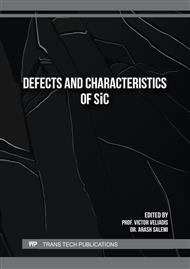[1]
B Jayant Baliga, Fundamentals of power semiconductor devices. New York, NY: Springer, 2008, Chap.3, pp.91-155.
Google Scholar
[2]
S.Wolf and R.N. Tauber, Silicon Processing for the VLSI Era Volume 1:Process Technology. Sunset Beach, U.S.A. : Lattice Press, 1986. pp.280-283.
Google Scholar
[3]
A. Agarwal, H. Fatima, S.Haney, S.-H. Ryu, "A New Degradation Mechanism in High-Voltage SiC Power Mosfets". IEEE Electron Device Letters vol. 28, no. 7, pp.587-589, 2007. doi.:.
DOI: 10.1109/LED.2007.897861
Google Scholar
[4]
D. Kim, N. Yun and W. Sung, "Advancing Static Performance and Ruggedness of 600 V SiC MOSFETs: Experimental Analysis and Simulation Study," 2021 IEEE International Reliability Physics Symposium (IRPS), 2021.
DOI: 10.1109/IRPS46558.2021.9405109
Google Scholar
[5]
S. A. Mancini et al., "Static Performance and Reliability of 4H-SiC Diodes with P+ Regions Formed by Various Profiles and Temperatures," 2022 IEEE International Reliability Physics Symposium (IRPS), 2022, pp. P62-1-P62-6.
DOI: 10.1109/IRPS48227.2022.9764538
Google Scholar
[6]
S. A. Mancini et al., "Investigation of Static Performances of 1.2kV 4H-SiC MOSFETs Fabricated Using All 'Room Temperature' Ion Implantations," in IEEE Journal of the Electron Devices Society, vol. 12, pp.150-158, 2024.
DOI: 10.1109/JEDS.2024.3359974
Google Scholar
[7]
S. A. Mancini et al., "Increased 3rd Quadrant Current Handling Capability of 1.2kV 4H-SiC JBS Diode-Integrated MOSFETs (JBSFETs) with Minimal Impact on the Forward Conduction and Blocking Performances," 2021 IEEE 8th Workshop on Wide Bandgap Power Devices and Applications (WiPDA), 2021, pp.101-106.
DOI: 10.1109/WiPDA49284.2021.9645152
Google Scholar
[8]
W. Sung and B. J. Baliga, "A Near Ideal Edge Termination Technique for 4500V 4H-SiC Devices: The Hybrid Junction Termination Extension," IEEE Electron Device Letters, vol. 37, no. 12, p.1609–1612, Dec. 2016.
DOI: 10.1109/led.2016.2623423
Google Scholar
[9]
S. A. Mancini et al., "Edge Termination Design Considerations for 1.2kV 4H-SiC MOSFETs While Utilizing Room Temperature Ion Implantations," 2023 IEEE 10th Workshop on Wide Bandgap Power Devices & Applications (WiPDA), Charlotte, NC, USA, 2023, pp.1-6.
DOI: 10.1109/WiPDA58524.2023.10382208
Google Scholar
[10]
Z. Chen et al, "Analysis of Basal Plane Dislocation Motion Induced by P+ Ion Implantation Using Synchrotron X-ray Topography" 2022 19th International Conference on Silicon Carbide and Related Materials (ICSCRM), September 2022.
DOI: 10.4028/p-6dx2v3
Google Scholar


